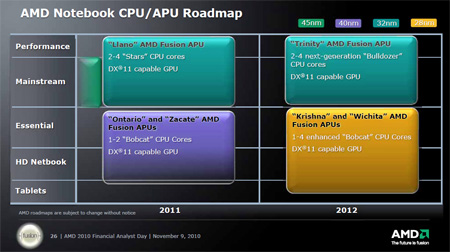AMD ships first Fusion chips, announces new APUs for laptops, desktops and tablets

Earlier today AMD shipped its first Fusion processors, which combine a CPU with a discrete GPU on a single chip, to customers. Those first APUs, or Accelerated Processing Units, will be available starting in January in some 100 different designs including ultra-thin laptops that AMD claims will deliver nine hours of battery life.
This was one of several announcements AMD made at its annual analyst's day earlier today, which was streamed live online (the full presentations are available here). Other highlights included demonstrations of next-year's Llano quad-core laptop APU and Zambezi 8-core desktop platform, updated laptop and desktop roadmaps through 2012 with some previously unannounced products that will extend to tablets, and a shift starting late next year to 28nm process technology.
The APUs that began shipping today are part of the Brazos platform using low-power Bobcat cores and a DirectX 11 GPU. This includes the single-core Ontario (rated at 9 watts) for netbooks and dual-core Zacate (18W) for ultra-thin laptops. Because AMD is using TSMC's existing 40nm manufacturing process--the same one used for Radeon GPUs--it was able to move these APUs from design to production in about half the typical time. These will be followed in 2012 by Krishna and Wichita, APUs with one to four CPUs that will be targeted not only at netbooks and ultraportables, but also tablet PCs. These will be manufactured using a 28nm "half-node" process and CEO Dirk Meyer said production of low-power 28nm APUs would start by the end of 2011.
To provide a better idea of the performance of Brazos, Emilio Ghilardi, a senior vice president and AMD's Chief Sales Officer, compared the HP Pavilion dv2 released at CES in January 2009 to the equivalent 12.1-inch ultra-thin version with Brazos that will be announced a CES in January 2011. The original dv2, which had an AMD Athlon Neo processor, "very little graphics capabilities" and a battery life of about three hours. The same system with Brazos will now have the graphics capabilities of a mid-range discrete GPU and a battery life of nine hours, he said. It will also cost "significantly less" than the original dv2, which started around $600. Rick Bergman, also a senior vice president and General Manager of the Products Group, demonstrated an ultraportable laptop with a Zacate APU playing back smooth HD video. He also showed a Llano system simultaneously playing an HD video and a DirectX 11 game, The Lord of the Rings Online: Shadows of Angmar.
For mainstream and performance laptops--where AMD traditionally plays--it will continue to sell the existing 45nm CPUs and discrete GPUs until Llano begins shipping in the second quarter of 2011. Llano will have a two to four higher-performance (and power) Stars CPUs integrated with a higher-performance DX11 GPU. Llano is not only the first 32nm processor from AMD and GlobalFoundries, but also the first product to use new materials (metal gates and a high-k insulator), and the challenges of manufacturing this are what have pushed it well into next year. AMD will stick with the same 32nm recipe for this mainstream segment in 2012, but it will introduce a new platform, Trinity, that will have two to four Bulldozer cores, the same CPUs that will be used in next-generation processors for high-performance desktops and servers. AMD will start shipping Trinity APUs to its customers next summer.
AMD will use the same platforms for much of its desktop line in 2011 and 2012. The low-power Ontario/Zacate and Krishna APUs will also appear in all-in-one desktops and small-form factor PCs. And Llano and Trinity will extend to mainstream desktops. Performance desktops are different story, however, since those systems will continue to require the performance of a discrete GPU. Next year AMD will introduce Zambezi with four to eight Bulldozer cores followed in 2012 by Komodo with eight updated Bulldozer cores. Komodo will also be an APU with an on-chip DirectX 11 GPU, but systems with APUs will continue to work with discrete GPUs as well, and the two GPUs will share graphics processing and GPU computing work. Both Zambezi and Komodo will be manufactured using GlobalFoundries' 32nm process with high-k and metal gates. Bergman also provided the first demonstration of a desktop running both a Zambezi 8-core processor and AMD's upcoming Cayman (Radeon HD 6970) discrete GPU, which he promised would be the must-have platform for gamers next year.
The basic Bobcat and Bulldozer designs that serve as the foundation for these platforms will be around for at least three generations. But during the day's presentations, AMD executives talked a lot about how they planned to develop the CPUs, GPUs and the peripherals that connect them over time to deliver a better user experience with Web browsing, (using browsers such as Internet Explorer 9 that support GPU acceleration), digital video creation and consumption, and of course 3D gaming. By increasing the "attach rate" for discrete GPUs--in other words, selling a lot more laptops and desktops with powerful graphics--AMD also hopes to give software developers a lot more incentive to develop more applications that exploit the power of GPUs using standards such as OpenCL and Microsoft's DirectCompute. The GPU will eventually become what Meyer and others described as a "first-class citizen" in the PC, seamlessly and intelligently sharing work with the CPU to deliver a better user experience in devices of all shapes and sizes.
